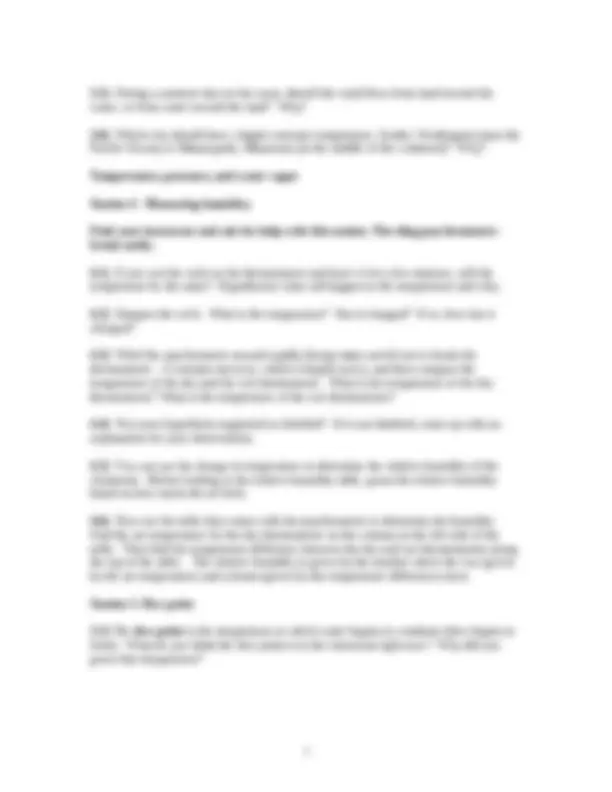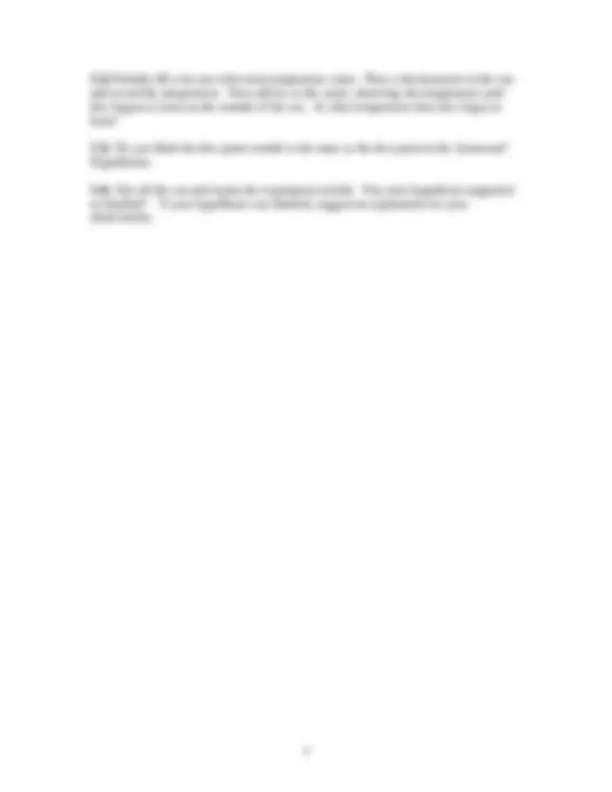




Study with the several resources on Docsity

Earn points by helping other students or get them with a premium plan


Prepare for your exams
Study with the several resources on Docsity

Earn points to download
Earn points by helping other students or get them with a premium plan
Community
Ask the community for help and clear up your study doubts
Discover the best universities in your country according to Docsity users
Free resources
Download our free guides on studying techniques, anxiety management strategies, and thesis advice from Docsity tutors
Material Type: Lab; Professor: Hannula; Class: Earth Systems Science; Subject: Geology; University: Fort Lewis College; Term: Unknown 1989;
Typology: Lab Reports
1 / 4

This page cannot be seen from the preview
Don't miss anything!



Earth Systems Science
“Weather” is a term that we use to explain the way that heat, pressure, and moisture are affecting the air around us. Each of these factors plays a significant role in what the weather will be like so it is important to understand the role and effects of each. The purpose of this lab is explore the relationships between temperature, pressure, humidity, and weather.
To understand some of the basic physical processes that control the development of weather
temperature air pressure relative humidity dew point evaporation
http://www.nws.noaa.gov/ Equipment needed: Thermometers Can of gas under pressure Candle Absorbent cloth, wet Wire or string Ice Bottle of soda Lamp Tin cans Beakers Box with a glass or plexiglass side, with two holes at the top
Station 1. Compressed gas. Start by examining the can of compressed gas. 1.1) What do you think will happen to the temperature of the can of compressed gas when you release some of the gas? (Releasing the gas will decrease the pressure on the gas contained in the can.) Should it stay the same, get hotter, or get colder? Formulate a hypothesis. 1.2) Why do you expect that the air within the can should stay the same temperature, get hotter, or get colder?
1.3) Release some of the gas. Was your hypothesis supported or falsified? If it was falsified, explain why the temperature behaved in the way that it did. 1.4) When air rises, its pressure decreases. What should happen to the temperature of a parcel of air as it rises? Station 2. Candles and chimneys. 2.1) For the next experiment, put your candle into your box underneath one of the two "chimneys". What should happen to the air in the chimney above the candle? What should happen to the air in the chimney that is not over the candle? Formulate a hypothesis about how the air in the box should move. 2.2) Why do you think the air will behave in the way you hypothesized it would? 2.3) Light the candle, close the box, and light the incense stick. Hold the incense stick over the second chimney. The smoke from the incense should show you how the air over the second chimney circulates. Sketch what happens to the incense smoke. 2.4) Does your observation support or falsify your hypothesis? If your hypothesis was falsified, come up with a new explanation of what happened. 2.5) When sunlight strikes the ground, the ground absorbs energy and warms up. The warm ground, in turn, heats the air just above it. What should happen to that air? 2.6) Major forest fires are said to "make their own weather." How do large forest fires affect local wind directions? Why do they affect local wind directions? Station 3. Heating land and water. For the next experiment, hang a light about 5 inches above the top of three beakers, one containing water (at room temperature), one containing dry sand, and one containing wet sand. Suspend a thermometer in each beaker so that the thermometer bulb is just below the water or sand surface. Don't turn on the light yet. 3.1) Which do you expect should heat up faster, the water, the dry sand, or the wet sand? Formulate a hypothesis. 3.2) Turn on the light and record the temperature at about one-minute intervals for about ten minutes. Record your observations in data table 3.2 on your answer sheet. 3.3) Turn off the lamp. Plot the temperature of the water, the dry sand, and the wet sand versus time on a sheet of graph paper. Use a different colored line to represent each type of material. 3.4) Was your hypothesis supported or falsified? If it was falsified, propose a different explanation for the phenomenon you observed.
5.2) Partially fill a tin can with room temperature water. Place a thermometer in the can and record the temperature. Now add ice to the water, observing the temperature until dew begins to form on the outside of the can. At what temperature does dew begin to form? 5.3) Do you think the dew point outside is the same as the dew point in the classroom? Hypothesize. 5.4) Dry off the can and repeat the experiment outside. Was your hypothesis supported or falsified? If your hypothesis was falsified, suggest an explanation for your observations.